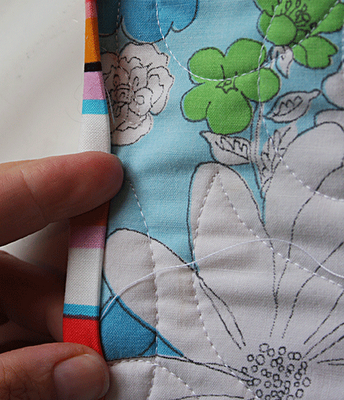Michele and I are having an exciting time building this new Learning Center here at the Quilting Gallery!
One of the most asked for items we both hear is ‘how to do better binding’. I thought this would be a terrific day to share two binding techniques.
Let me share what I do first. I decided a few years ago to ‘time’ how long it took me to hand stitch my binding. WOW! What an eye opener that was. I do enjoy hand work, I do enjoy that relaxing stitch stitch stitch… but I’d much rather appliqué than bind. So I went on a search for a binding technique that was pretty much ALL machine. I have fine-tuned it to a blanket stitch that I pull to the front… mitred corners and all… then stitch on the machine. I finish my bindings in a fraction of the time it took me before.
And the bonus is, they are much sturdier than a hand stitched binding. After 12 years of hauling my quilts around to presentations and workshops, I’m having to repair my bindings… and these quilts are really not ‘used’ that much! Take a look at my online binding tutorial… give it a try… let me know if you like it! P.S. there is a printable version at the end of the page.
Then I asked my friend Dana Bolyard of Old Red Barn Co. to guest post about binding… she makes it sound so simple! Also listen to my interview with Dana at the recorded show from Feb 13, 2012.
Quilt Binding – A Primer by Dana Bolyard
Ah! Binding a quilt is the last step towards completion of a quilt and it’s no secret that it’s my absolute most favorite part of the process. I love everything from choosing the fabric for binding, making the binding, attaching it and then hand sewing it to the back. I think it has something to do with being able to sit under the quilt while I work and slowly sewing.
And admiring the nearly completed project as I go.

Of course, the binding is the narrow strip of fabric at the outer most edge of the quilt that finishes off the quilt and covers the raw edges. But really it’s more than that to me. It’s the frame around the picture.

The binding is that last finishing touch. It’s like a picture frame to a photograph or a gold gilded frame to a fine art masterpiece. It literally frames your quilt … especially if the quilt is borderless.

You take time choosing just the right frame for a prized photograph and the same should be true for choosing the binding fabric. Start with quality 100% quilters’ cotton. The binding will be handled and pulled and tugged on much during its service and must be strong and durable.

You’ll notice in all of the pictures above that each of the bindings are a bold hued color marking the outer edge of the quilt. Walk into any quilt shop and study the quilts on display throughout the store. Do the same at any quilt exhibit. You will notice that 95% of the time the color of the binding picks up on the darker hues within the quilt top itself. I like to think of it as the final punctuation on the quilt top.
Or, as I’ve said repeatedly, the outer most beautiful frame of your masterpiece. By picking up on the darker hues in the quilt itself, the binding serves it’s framing function perfectly.

Making the binding, machine sewing it to the front, mitering the corners and then hand sewing it to the back may seem intimidating but I’ve provided a step-by-step tutorial with photos.





You can access it here: How to Bind a Quilt.
Don’t panic! Binding a quilt is relaxing, enjoyable and the finishing touch your quilt is begging for!
Dana Bolyard
Old Red Barn Co.
Here are a few additional resources for binding your quilts:
- Award winning quilter, Sharon Schamber, shares video tutorials of her binding technique using Elmer’s school glue
- More video tutorials from Sharon Schamber on curved binding
- Julie Herman from Jaybird Quilts has a great series of posts on binding basics
What’s your favourite binding method? Do you have any binding tips or tools you like to use? Share in the comments below.
Michele will be doing next week’s Learning Center post, Beyond the Basics … More Tools, featuring favourite tools from our readers and some great give-aways too.
Pat Sloan is owner and founder of the quilting design and publishing company Pat Sloan & Co. She has published over 25 books, more than 100 patterns, nearly 10 fabric lines, and has had her work featured in all the major Quilt magazines. In January 2010, Pat started hosting her weekly Internet Radio show called Creative Talk Radio.
Find Pat here:
Web Site | Blog | Radio Show | Facebook | Twitter
Quilt Forum | Pinterest | Newsletter




Leave a Reply